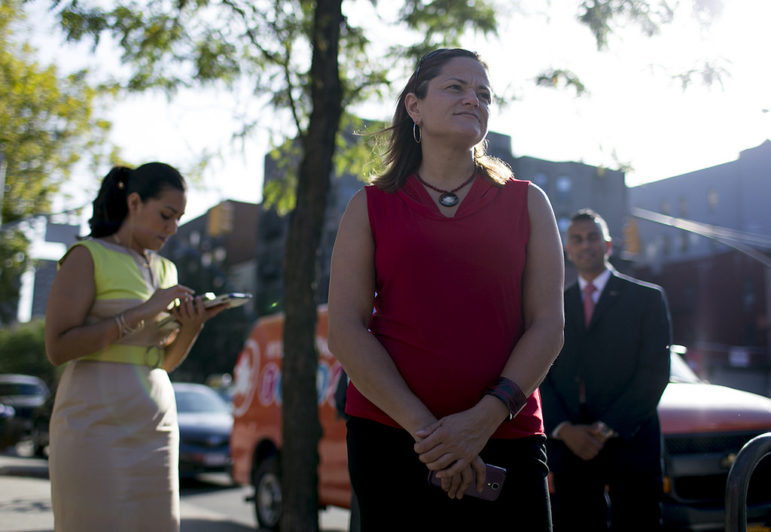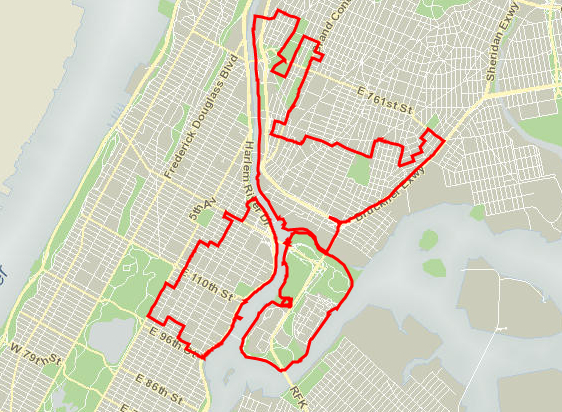
William Alatriste
Speaker Melissa-Mark Viverito, who is leaving office because of term limits, seen in the district in 2014. The 8th district’s lines were redrawn before the 2013 race to encompass more of the Bronx.
Only two New City Council districts cross borough lines, and only the 8th district spanning Manhattan and the Bronx actually crosses a river—in this case, the Harlem River—to do so.
The water isn’t what makes the area interesting, however, but the fact that the district joins the traditional cultural heart of Latino New York (El Barrio/East Harlem) to southernmost part of the South Bronx, including Mott Haven, long one of the city’s most impoverished districts, does. There’s probably no neighborhood in the city more likely to gentrify—or gentrify more, since the process appears to have started already in at least some areas—and the possible rezoning of East Harlem has been controversial because of the real risk of displacement. That the outgoing Council speaker, Melissa Mark-Viverito, represents that district, that her trusted aide Diana Ayala is a leading candidate in the campaign to succeed her, and that Mark-Viverito’s handling of the rezoning could shape the race all make it a fascinating place to watch on September 12.

NYCGIS
Bronx land dominates the district but the voting population is split about evenly.
(For more on who’s running in the district encompassing El Barrio/East Harlem in Manhattan and Mott Haven, Highbridge, Concourse, Longwood and Port Morris in the Bronx, click here. And for news and video from a recent candidate forum in the district, go here.
The Council district’s voters are split pretty evenly between the Manhattan (55,141 voters) and Bronx (51,663) sides, the result of a 2012-13 redistricting that expanded the Bronx footprint.
Just shy of 80 percent of voters are registered Democrats. Voters who identified no party when they registered outnumber Republicans in District 8 by better than three to one. Election results reflect these disparities. Mark-Viverito faced no general election opponent in 2005 and 2009 and bested her Republican challenger four years ago by a four-to-one margin.
Primaries have been a different (and way more competitive) story: Mark-Viverito won her first primary race in 2005 against a field of five other candidates with 26 percent of the vote. In 2009, against five challengers, she nabbed 47 percent but in 2013 she won with only 35 percent of the vote in a six-person field.
If the statistics reported by the Furman Center in its annual State of New York City Housing & Neighborhoods report are any guide, the district combines economic isolation and transit access; the latter is a positive unless you are worried about real-estate developers being able to see the area to wealthy tenants as a hop, skip and a jump from the rest of the city. Bronx Community District 1, which overlaps with most of the Bronx side of the Council district, has a 40 percent poverty rate and ranks No. 1 for residential units within a half mile of a subway station. The poverty rate in the East Harlem half (Manhattan Community Board 11) is 37.5 percent. Rent burdens, however, are relatively low.
According to the New York City Campaign Finance Board’s searchable database, the top five recipients of campaign donations from the four ZIP codes that encompass the majority of district 8 include Robert Rodriguez and Diana Ayala, two of the candidates vying to replace Mark-Viverito, as well as the Councilwoman herself, the mayor and the Bronx Borough President.
center>* * * *
Get our free
Election Watch
bulletin
today.
* * * *









2 thoughts on “The 8th Council District: A River Runs Through It”
Pingback: The Politics Of The Harlem River Divide In The 8th Council District - Harlem World Magazine
Pingback: The 8th Council District: A River Runs Through It - This Is The Bronx